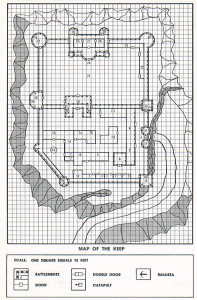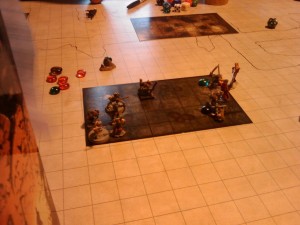Ale Break: Keep on the Borderlands
It all started when I ordered a copy of the AD&D adventure “Vault of the Drow”. I like to read over these old modules and see how the original writers of this game conceived adventures. I was so taken with “Vault” that I also got “Descent into the Depths of the Earth”. I liked them so much that I decided I wanted to run or play in them. But with the two weekly games I run in mid-progress I felt like I was pretty much booked up.Wednesdays we play “Savage Tide”. At 16th level, they’re in the home stretch: 4 more adventures to go, and I don’t want to lose momentum on this game.
Sundays I run a D&D game for some friends and co-contributors to Unicorn Rampant. I’ve been running a homebrew campaign I call “The Heir of Soguer”, but have had a little writer’s block lately. So I thought, here’s a chance for us to take a little break from “Heir” and revisit some old adventures I haven’t played since high school or have never had a chance to play.
So far it’s been a blast running “Keep on the Borderlands”. I came up with a place to put the keep in my campaign world and told the players the story was taking place 10 years before the story I’m telling in “Heir”. I then told them they were from the Temple of the Stars, a historically important location they’re headed to in “Heir” and worked on backgrounds for their characters. I then and gave them their quest: go to the Keep on the Borderlands, where bandits are raiding travelers, and lend a hand however they can. This gave me a way to tie this side trek into the current game: it gives the players some foreshadowing of what they’re about to encounter in “Heir”. The quest is also the type of cheesy, simple old-school adventure hook that gave the game a great starting flavor.
It’s been wonderfully nostalgic running Keep. The players got to the famous “Castallian Keep” and started wandering around, meeting the locals and soaking up the medieval flavor.

I had to come up with names for all the NPCs, since that’s the one detail omitted from the town descriptions. For those who have never seen Keep on the Borderlands, there are elaborate descriptions of lots of things, including the contents of every drawer in the moneylender’s shop and the traps guarding each drawer, but the people there are “scribe: mu2, ac:9, at:1, dmg: 1-4, spells: ventriloquism, grease”. And you thought 4e stat blocks were short 🙂 All together the adventure is about 20 pages with the area descriptions, treasure, hidden features and stats all run together in a single paragraph for each area. Adventures have come a long way in 30 years, although you still sometimes see this.
Once they got to the Caves of Chaos and started in on the meat of the dungeon, I started converting the encounters on the fly. According to the 4e DMG, each 1st level character in the encounter merits 100 xp worth of monsters, up to 175 xp for a really tough challenge. The adventure says there are 6 goblins in the first room, and I have 3 players. So I went with four goblin minions at 25 xp each, and two 1st level goblins at 100 xp each for a total of 300 xp worth of monsters. If there were only 3 goblins called for I made them all 1st level goblins at 100 xp each, or two 2nd level at 150 xp each and a minion for 25 xp. It worked out quite nicely; I was able to run the adventure from a single page in the monster manual, so there wasn’t a bunch of flipping around from book to book. Between this and buying 14 goblin minis this kept the players from guessing who were minions and who weren’t.
All of this made me think about how simple the monsters were in AD&D. They had a HD, which determined their “BAB”, and a number of attacks and damage. They also had a morale score, and if they were special they had a “saves as” entry. Unless they had spells or special abilities, that was it. Compare that to the 3e stat block for a goblin: 23 lines of information jammed together in a poorly orgznized format. Of course, that format was inherited form the old AD&D monster manual. Paizo improved drastically on the readability of that format in their Dungeon Magazine by organizing the stats in sections, and we use that format here at Unicorn Rampant for our Claw/Claw/Bite! line of products, but there can still be a lot of digging around required of the DM compared to having only 5 or 6 numbers as stats for a monster. Now, in 4e, you can almost run all your monsters from a single chart again. I keep thinking I’m going to write up a spreadsheet that takes monster level and role and spits out complete stats.
For running the dungeon I used our big Chessex mondomat, as usual, and tried out the Dungeon Mastery dungeon tiles from Piazo that I got at GenCon last year. I was really happy with them: they add a lot of good-looking detail to the game without taking a lot of time to draw. Lack of good corridors is the only real weakness of the tiles, but it’s easy enough to draw the corridors and use the tiles for the rooms along the way. I’m thinking I’m going to pick up another set or two and copy some of the corridors in the back of the DMG for the next session.
 I just got all three modules of the “Against the Giants” series, so hopefully we’ll keep enjoying these old adventures enough to string together a campaign out of them.
I just got all three modules of the “Against the Giants” series, so hopefully we’ll keep enjoying these old adventures enough to string together a campaign out of them.
Thanks to W.o.G. for inspiring me to get “Vault of the Drow” and sending me down this old path once again.
-Adam
Posted in Editorial and tagged ale break by Adam A. Thompson with 2 comments.
Leave a Reply